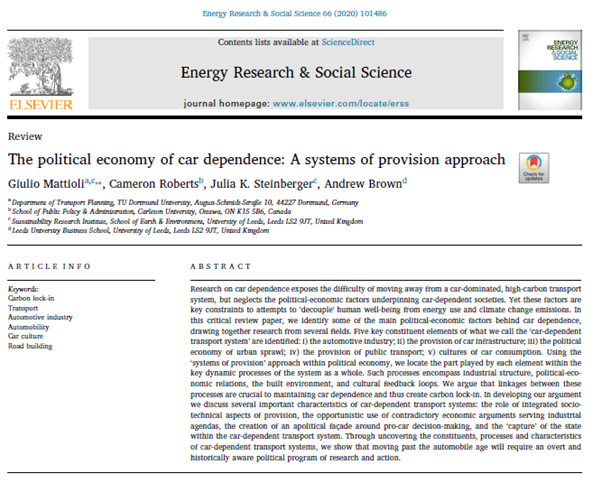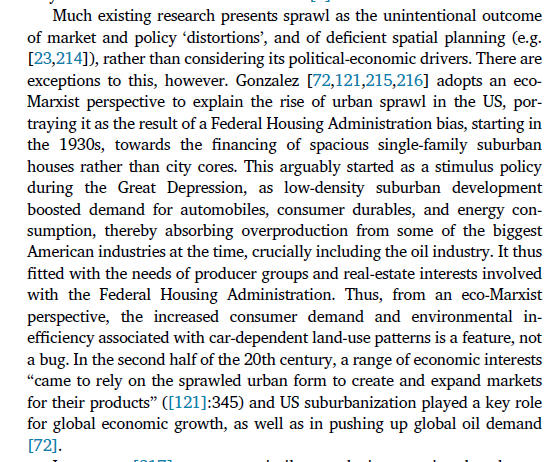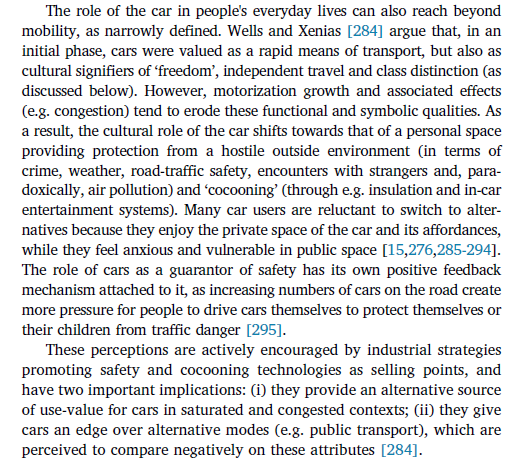For the #ClimateCrisis, we need to reduce car ownership & use. And yet it’s so hard to do. Why?
We believe it has to do with the political economy of car dependence
Thread on my new @liliproj paper with @JKSteinberger @bikeademic & Andrew Brown
https://doi.org/10.1016/j.erss.2020.101486">https://doi.org/10.1016/j...
We believe it has to do with the political economy of car dependence
Thread on my new @liliproj paper with @JKSteinberger @bikeademic & Andrew Brown
https://doi.org/10.1016/j.erss.2020.101486">https://doi.org/10.1016/j...
If you sometimes find sustainable transport research / discourse
 https://abs.twimg.com/emoji/v2/... draggable="false" alt="➡️" title="Rightwards arrow" aria-label="Emoji: Rightwards arrow"> too apolitical
https://abs.twimg.com/emoji/v2/... draggable="false" alt="➡️" title="Rightwards arrow" aria-label="Emoji: Rightwards arrow"> too apolitical
 https://abs.twimg.com/emoji/v2/... draggable="false" alt="➡️" title="Rightwards arrow" aria-label="Emoji: Rightwards arrow"> too much focused on consumption
https://abs.twimg.com/emoji/v2/... draggable="false" alt="➡️" title="Rightwards arrow" aria-label="Emoji: Rightwards arrow"> too much focused on consumption
 https://abs.twimg.com/emoji/v2/... draggable="false" alt="➡️" title="Rightwards arrow" aria-label="Emoji: Rightwards arrow"> too much focused on ‘win-win-win’
https://abs.twimg.com/emoji/v2/... draggable="false" alt="➡️" title="Rightwards arrow" aria-label="Emoji: Rightwards arrow"> too much focused on ‘win-win-win’
You might like this review paper.
You might like this review paper.
We adopted a heterodox economics approach to look into the main factors underpinning car dependence, across both consumption *and production*.
Find them below in our tongue-in-cheek ‘evil pentagram of car dependence (which does *not* appear in this form in the paper https://abs.twimg.com/emoji/v2/... draggable="false" alt="😊" title="Smiling face with smiling eyes" aria-label="Emoji: Smiling face with smiling eyes">)
https://abs.twimg.com/emoji/v2/... draggable="false" alt="😊" title="Smiling face with smiling eyes" aria-label="Emoji: Smiling face with smiling eyes">)
Find them below in our tongue-in-cheek ‘evil pentagram of car dependence (which does *not* appear in this form in the paper
The 1st element of the political economy of car dependence is the car industry. This is incredibly neglected by sustainable transport research & discourse.
Take me as a (bad) example: I’m a car dependence researcher, and until 2017, I hadn’t seriously engaged with the topic
Take me as a (bad) example: I’m a car dependence researcher, and until 2017, I hadn’t seriously engaged with the topic
The key characteristics of the automotive industry ( https://abs.twimg.com/emoji/v2/... draggable="false" alt="⬇️" title="Downwards arrow" aria-label="Emoji: Downwards arrow">
https://abs.twimg.com/emoji/v2/... draggable="false" alt="⬇️" title="Downwards arrow" aria-label="Emoji: Downwards arrow"> https://abs.twimg.com/emoji/v2/... draggable="false" alt="⬇️" title="Downwards arrow" aria-label="Emoji: Downwards arrow">
https://abs.twimg.com/emoji/v2/... draggable="false" alt="⬇️" title="Downwards arrow" aria-label="Emoji: Downwards arrow"> https://abs.twimg.com/emoji/v2/... draggable="false" alt="⬇️" title="Downwards arrow" aria-label="Emoji: Downwards arrow">) have important implications for car dependence. And once you wrap your head around them, a lot of things start to make sense.
https://abs.twimg.com/emoji/v2/... draggable="false" alt="⬇️" title="Downwards arrow" aria-label="Emoji: Downwards arrow">) have important implications for car dependence. And once you wrap your head around them, a lot of things start to make sense.
For example: sustainable transport people complain about large 5-seater vehicles that are systematically under-occupied (“1 ton to transport 1 person!”). It doesn’t make sense right?
Expect, it does. *From an industry perspective* it does: it& #39;s essental for economies of scale
Expect, it does. *From an industry perspective* it does: it& #39;s essental for economies of scale
The rest of the review paper is too long to be summarised in a thread - @JKSteinberger calls it “an insane tour de force”, and people have teased me on my "opus" for years. So I’ll just give you some highlights here.
We classify the arguments used to justify road building (keep an eye on 1b in the #COVID crisis!). They’re inconsistent, but they appeal to all persuasions –all bases are covered. So road building is seen as ‘apolitical’, almost as a proof of political competence.
Sprawling land use. We tend to see it as a sort of ‘mistake’ – something which is wasteful, irrational, which we wouldn’t do if only we knew better.
But perhaps we should see it as a feature more than a bug = a form of stimulus to certain industries (including automotive)
But perhaps we should see it as a feature more than a bug = a form of stimulus to certain industries (including automotive)
Sprawl also ‘drives politics’, as those who live there are more likely to support ‘hidden subsidies’ to automobility & oppose investment in alternative modes.
This explains some of the increasing electoral polarisation between suburbs & cities + it’s a positive system feedback
This explains some of the increasing electoral polarisation between suburbs & cities + it’s a positive system feedback
Public transport is difficult to provide when land-use is car-oriented. You need ‘network planning’. But that requires some degree of public control.
PT systems that are too privatised/deregulated (e.g. UK, many developing countries) struggle with that.
Again, it& #39;s political.
PT systems that are too privatised/deregulated (e.g. UK, many developing countries) struggle with that.
Again, it& #39;s political.
Finally, let’s not forget the consumption / cultural side of car dependence. The car is embedded in our culture in so many ways, and these have a long history behind them. We trace the links between culture and the other elements of the system.
The paragraph below on cars as cocoons vs. public space was written pre- #COVID19, but might be relevant for our post-pandemic future
Overall, the underlying characteristics of car dependence are:
 https://abs.twimg.com/emoji/v2/... draggable="false" alt="➡️" title="Rightwards arrow" aria-label="Emoji: Rightwards arrow"> the opportunistic use of contradictory economic arguments serving industrial agendas
https://abs.twimg.com/emoji/v2/... draggable="false" alt="➡️" title="Rightwards arrow" aria-label="Emoji: Rightwards arrow"> the opportunistic use of contradictory economic arguments serving industrial agendas
 https://abs.twimg.com/emoji/v2/... draggable="false" alt="➡️" title="Rightwards arrow" aria-label="Emoji: Rightwards arrow"> state-capture by the complex of car-dependent transport systems
https://abs.twimg.com/emoji/v2/... draggable="false" alt="➡️" title="Rightwards arrow" aria-label="Emoji: Rightwards arrow"> state-capture by the complex of car-dependent transport systems
 https://abs.twimg.com/emoji/v2/... draggable="false" alt="➡️" title="Rightwards arrow" aria-label="Emoji: Rightwards arrow"> the apolitical facade around pro-car decision-making
https://abs.twimg.com/emoji/v2/... draggable="false" alt="➡️" title="Rightwards arrow" aria-label="Emoji: Rightwards arrow"> the apolitical facade around pro-car decision-making
In a nutshell, our argument is that if you’re framing sustainable transport as an apolitical endeavour, you’re really not doing yourself any favour https://www.youtube.com/watch?v=mcaUer4fuU8">https://www.youtube.com/watch...
The paper owes so much to @JKSteinberger (for the relentless motivation & vision & synthesis) & @bikeademic (who is all-knowing about cars, and edits my prolix prose like no other) & Andrew Brown who converted us all to heterodox economics.
I mean we’ve even got a pentagram it doesn’t get more heterodox than this! (ends)
PS: here is a great thread on the paper by @FrontierTony - he expands on some important points https://twitter.com/FrontierTony/status/1252951524570996739">https://twitter.com/FrontierT...
And here a thread by co-author (and @liliproj project leader) @JKSteinberger.
Spoiler: it includes pentagrams, lots of them https://abs.twimg.com/emoji/v2/... draggable="false" alt="😆" title="Smiling face with open mouth and tightly-closed eyes" aria-label="Emoji: Smiling face with open mouth and tightly-closed eyes"> https://twitter.com/JKSteinberger/status/1252277381060087808">https://twitter.com/JKSteinbe...
https://abs.twimg.com/emoji/v2/... draggable="false" alt="😆" title="Smiling face with open mouth and tightly-closed eyes" aria-label="Emoji: Smiling face with open mouth and tightly-closed eyes"> https://twitter.com/JKSteinberger/status/1252277381060087808">https://twitter.com/JKSteinbe...
Spoiler: it includes pentagrams, lots of them
PS/2 - I forgot to say: The paper is #OpenAccess. So don& #39;t assume that you need institutional access / to pay an insane fee to read it, because you don& #39;t!

 Read on Twitter
Read on Twitter
 )" title="We adopted a heterodox economics approach to look into the main factors underpinning car dependence, across both consumption *and production*. Find them below in our tongue-in-cheek ‘evil pentagram of car dependence (which does *not* appear in this form in the paper https://abs.twimg.com/emoji/v2/... draggable="false" alt="😊" title="Smiling face with smiling eyes" aria-label="Emoji: Smiling face with smiling eyes">)" class="img-responsive" style="max-width:100%;"/>
)" title="We adopted a heterodox economics approach to look into the main factors underpinning car dependence, across both consumption *and production*. Find them below in our tongue-in-cheek ‘evil pentagram of car dependence (which does *not* appear in this form in the paper https://abs.twimg.com/emoji/v2/... draggable="false" alt="😊" title="Smiling face with smiling eyes" aria-label="Emoji: Smiling face with smiling eyes">)" class="img-responsive" style="max-width:100%;"/>
 https://abs.twimg.com/emoji/v2/... draggable="false" alt="⬇️" title="Downwards arrow" aria-label="Emoji: Downwards arrow">https://abs.twimg.com/emoji/v2/... draggable="false" alt="⬇️" title="Downwards arrow" aria-label="Emoji: Downwards arrow">) have important implications for car dependence. And once you wrap your head around them, a lot of things start to make sense." title="The key characteristics of the automotive industry (https://abs.twimg.com/emoji/v2/... draggable="false" alt="⬇️" title="Downwards arrow" aria-label="Emoji: Downwards arrow">https://abs.twimg.com/emoji/v2/... draggable="false" alt="⬇️" title="Downwards arrow" aria-label="Emoji: Downwards arrow">https://abs.twimg.com/emoji/v2/... draggable="false" alt="⬇️" title="Downwards arrow" aria-label="Emoji: Downwards arrow">) have important implications for car dependence. And once you wrap your head around them, a lot of things start to make sense." class="img-responsive" style="max-width:100%;"/>
https://abs.twimg.com/emoji/v2/... draggable="false" alt="⬇️" title="Downwards arrow" aria-label="Emoji: Downwards arrow">https://abs.twimg.com/emoji/v2/... draggable="false" alt="⬇️" title="Downwards arrow" aria-label="Emoji: Downwards arrow">) have important implications for car dependence. And once you wrap your head around them, a lot of things start to make sense." title="The key characteristics of the automotive industry (https://abs.twimg.com/emoji/v2/... draggable="false" alt="⬇️" title="Downwards arrow" aria-label="Emoji: Downwards arrow">https://abs.twimg.com/emoji/v2/... draggable="false" alt="⬇️" title="Downwards arrow" aria-label="Emoji: Downwards arrow">https://abs.twimg.com/emoji/v2/... draggable="false" alt="⬇️" title="Downwards arrow" aria-label="Emoji: Downwards arrow">) have important implications for car dependence. And once you wrap your head around them, a lot of things start to make sense." class="img-responsive" style="max-width:100%;"/>






